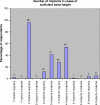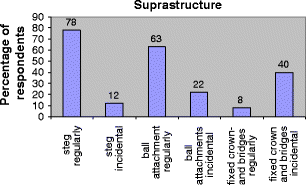Implants in the severely resorbed mandibles: whether or not to augment? What is the clinician's preference?
- PMID: 21853249
- PMCID: PMC3221860
- DOI: 10.1007/s10006-011-0285-6
Implants in the severely resorbed mandibles: whether or not to augment? What is the clinician's preference?
Abstract
Introduction: The aim of this study is to inventory in the Netherlands which therapy is the clinician's first choice when restoring the edentulous mandible.
Material and methods: A questionnaire was sent to all Dutch Oral and Maxillofacial surgeons. As part of this, the surgeons were invited to treat five virtual edentulous patients, differing only in mandibular residual height.
Results: In cases of a sufficient residual height of 15 mm, all surgeons were in favour to insert solely two implants to anchor an overdenture. In case of a residual height of 12 mm, 10% of the surgeons choose for an augmentation procedure. If a patient was presented with a mandibular height of 10 mm, already 40% of the OMF surgeons executed an augmentation procedure. Most (80%) surgeons prefer the (anterior) iliac crest as donor site. The choice of 'whether or not to augment' was not influenced by the surgeon's age; however, the hospital, where he was trained, did. Surgeons trained in Groningen were more in favour of installing short implants in mandibles with reduced vertical height.
Discussion: As the option overdenture supported on two interforaminal implants is reimbursed by the Dutch health assurance, this treatment modality is very popular in the Netherlands. From a point of costs and to minimize bypass comorbidity, surgeons should be more reluctant in executing augmentation procedures to restore the resorbed edentulous mandible as it is dated in literature that also in mandibles with a residual height of 10 mm or less, solely placing implants, thus without an augmentation procedure in advance, is a reliable treatment option.
Figures






Similar articles
-
Implantology and the severely resorbed edentulous mandible.Crit Rev Oral Biol Med. 2004 Jul 1;15(4):240-8. doi: 10.1177/154411130401500406. Crit Rev Oral Biol Med. 2004. PMID: 15284188 Review.
-
The extremely resorbed mandible, 10-year results of a randomized controlled trial on 3 treatment strategies.Clin Oral Implants Res. 2014 Aug;25(8):926-32. doi: 10.1111/clr.12184. Epub 2013 May 3. Clin Oral Implants Res. 2014. PMID: 23638947 Clinical Trial.
-
Implant treatment in atrophic posterior mandibles: vertical regeneration with block bone grafts versus implants with 5.5-mm intrabony length.Int J Oral Maxillofac Implants. 2014 May-Jun;29(3):659-66. doi: 10.11607/jomi.3262. Int J Oral Maxillofac Implants. 2014. PMID: 24818205
-
The extremely resorbed mandible: a comparative prospective study of 2-year results with 3 treatment strategies.Int J Oral Maxillofac Implants. 2004 Jul-Aug;19(4):563-77. Int J Oral Maxillofac Implants. 2004. PMID: 15346755 Clinical Trial.
-
Addressing the atrophied mandible: a proposal for a treatment approach involving endosseous implants.Int J Oral Maxillofac Implants. 2011 May-Jun;26(3):607-17. Int J Oral Maxillofac Implants. 2011. PMID: 21691609 Review.
Cited by
-
Pre-implantological treatment routines for alveolar ridge atrophy - an investigation among maxillofacial and oral surgeons in southern Germany.BMC Oral Health. 2020 Jul 8;20(1):195. doi: 10.1186/s12903-020-01179-3. BMC Oral Health. 2020. PMID: 32641041 Free PMC article.
References
-
- McCord JF, Grant AA, Quayle AA. Treatment options for the edentulous mandible. Eur J Prosthodont Resto Dent. 1992;1:19–23. - PubMed
-
- Szabo J. Methode zur Verhinderung des Verursachens der durchtrennten Mundschleimhaut. Öst-ungVjschr Zahnheilk. 1916;32:244.
-
- Tideman H (1973) Vestibulum plastiek met het vrije mucosa transplantaat. Dissertation. University of Amsterdam
MeSH terms
Substances
LinkOut - more resources
Full Text Sources
Research Materials

